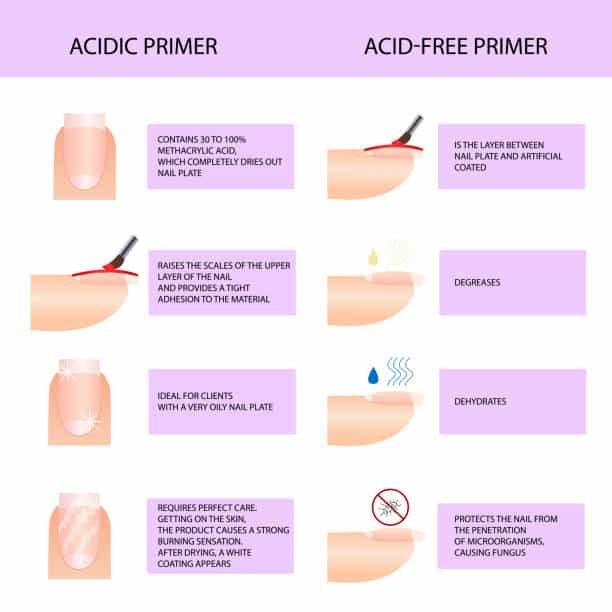A nail primer is used before a gel manicure to prime the nail. If you want your base coat to stay on your nails, you must clean off the oil and grease from them. Nail primers come in a variety of forms. Some are acid-free, while others contain acids. The most popular type of nail primer is one that is acid-free. On the other hand, you can use nail primers to create tiny cracks and fissures in your nail plates so that the acrylics and polishes can better adhere but never neglect your nail care. There are two types of primers,
1. Acid primer, 2. Acid-free primer.
Acid nail primer vs acid-free nail primer
The acid-free primer is the most common one to be used on natural nails for better adhesion. The acidic primer works best for people who have extra oily nails due to hormonal problems or medications. It helps in creating a matte surface to avoid air bubbles during gel polish or acrylic application.
Acidic nail primer
- Acidic primer is called acidic because 95% part consists of methacrylic acid.
- The acidic primer dries on the nail plate in 3-5 minutes, resulting in a whitish color.
- If an acidic primer comes into direct contact with the skin due to negligence, it can cause irritation and chemical burns.
- They can turn the enhancement yellow if not used correctly.
- It’s important to use extreme caution while using acid-based primers.
- Apply it sparingly. Simply dot it on the natural nail in tiny circles (using 5 nails at a time before putting the brush back into the bottle) until dry.
- Avoid touching any surrounding soft tissue when applying primer.
- When it involves acid-based primers, less is certainly more!
Acid-free nail primer
- The most preferred and most used product for increasing the adhesion of products to the natural nail plate is Acid-Free Primer.
- It’s irreplaceable whether you create gel nails, acrylic nails, or gel polish manicures.
- Gel technology, in particular, requires this.
- The enhancement will not discolor or burn the skin if you use an acid-free primer.
- Use acid-free primer to ensure a firm bond.
- It protects the style from air pockets and lifting the product.
- It binds the plate extremely firmly with gel polish and gel bases.

Homemade or Substitute of a Nail Primer
The simplest option for making a DIY Nail Primer and Dehydrator is to use a mix of Acetone and Isopropyl Alcohol. Because of the moisture and the oil on your nails, your acrylics, gel polish, and even regular polish are unable to adhere to your nail plate.
How to use
- Apply a coat of alcohol, then one of acetone, over your nails.
- Using an old but clean nail polish brush.
- To clean your hands, apply Isopropyl Alcohol to your nails.
- After the alcohol has evaporated, you may apply a coat of acetone to your nails.
- Allow the acetone to evaporate. Finally, you may begin using your products once the acetone has fully dried.
Benefits
When alcohol is used on your nails, it kills any germs that may be on the surface of your nail. On the other hand, the greasy sediments are dissolved, and the dirt & debris are subsequently removed when acetone is applied to your fingernails,
who should apply nail primer?
Those who face a lot of nail lifting or chipping issues should apply nail primer to get their gel nails or acrylics or press on nails last longer. Also, if your nails are extra oily than you must apply nail primer to provide a matte surface where products could adhere properly. However, if your gel nails can last more than 2 weeks without chipping or lifting than its not necessary to apply nail primer.
When should I apply nail primer
Normally, the regualr nail polishes or press on nails like BTArtboxnails won’t require nail primer application, though you can try it. However, you must apply nail primer to get the long lasting and healthy manicures for the following nail products.
How to apply nail primer?
As the nail primers have different types. keep reading to know how both of these nail primer types should be applied to get better results.
Acid-free primer
The first component in your manicure is always a primer. Apply an acid-free primer to each nail with a nearly dry brush, allowing it to dry for around 40-60 seconds. It’s acceptable to work on an acid-free primer that hasn’t completely evaporated because it won’t fully evaporate. After that you can apply a base coat to the natural nail.
Acid primer
Before applying an acid primer, apply 1-2 small dots to the nail. As a result, it will then spread across the nail plate on its own. Before applying your gel manicure with acid primer, ensure it has fully evaporated.
Nail prep dehydrator and nail primer: what is the difference
The Nail Prep dehydrator is a degreasing Liquid applied before the nail primer. It gently dehydrates and cleanse the natural nail surface by removing oil or moisture. The nail dehydrator is composed of mainly two ingredients: isopropyl alcohol and acetone. This product seals the nail pores after polishing them to make them matte which helps in avoiding air bubbles. It does not change the nail’s own PH and is therefore suggested for obtaining optimal results while doing a permanent nail polish service. Using it for several services in a row can help us to minimize oil formation on our nails during our job.
What is the difference between Nail primer and base coat
The main difference between the base coat and nail primer is that the base coat provides an extra layer of protection to your natural nail from nail polish’s stain and also it provides a smooth suface so your gel polish or acrylics could adhere better to natural nail without any air bubbles. On the other hand the purpose of nail primer and nail dehydrator is to cleanse and degrease the natural nail surface to close the open pores to provide a clean surface.
What does Nail primer do?
A primer can remove any moisture, oil, or grease from the surface of your nails. The results will be good and long-lasting if you get a manicure after all this. The purpose of a primer is to dehydrate your nails to allow your acrylics or polish to adhere better. You should use primers or dehydrators when necessary, such as when applying acrylics or when you’re prone to peel or chip.
Modelones 5 Pcs Set
Nail Primer, Nail Dehydrator, No Wipe Base, Top Coat, Cuticle Oil
- professional manicure set for the perfect foundation
- acid-free formula for healthy skin and nail
- Suitable for all types of nails, gel nails, acrylic powder, extension gel, dip powder, and liquid systems.
- Discounted Price
What does Base coat do?
A Base Coat is a clear polish that is used on your nails to make a gel or regular nail polish last longer. They will help your polish adhere more readily to the nail and protect the nails from staining. Plasticizers in base coats enhance their flexibility and adherence to the nail. If your natural nails appear yellowish, you should invest in a good base coat that has stain-preventing qualities. Base coats protect the integrity of your nails by forming a protective layer on top of them. This protects your nails from any potentially harmful chemicals in your polish or gel. citation
Base Coat Quick- Dry
FAQs
Do you apply nail primer before base coat?
Most experts agree that a nail primer and base coat are required before applying acrylic nails. To ensure that the acrylic nail adheres properly, the nail is primed with a special nail primer. Primer is crucial for acrylic nails because it aids in building a solid adhesion between the natural nail and the acrylic, says top nail industry expert Doug Schoon. Then you can apply a base coat after it. Citation
Do experts recommend using nail primer before base coat for polygel nails
Polygel nails, a new manicure trend, combine acrylic and gel nail benefits. Polygel nails usually require a primer and base coat.
However, Polygel nails should be primed and base coated, according to Gelish global educator Gina Silvestro. She told Nails Magazine that the primer strengthens the link between the natural nail and the polygel, while the base coat prepares the nail for polygel application.
Does nail primer need to be cured?
No, it’s not necessary to cure the nail primer or put it under UV light; however, if you see any lifting, you can cure it; otherwise not necessary.
How long does nail primer take to dry?
Acid-free nail primers usually take only 40-60 seconds to get dried.
Do you cure primer for gel nails?
Not required; you can skip curing primer for gel nails.
Can I use a base coat as a primer for acrylic nails?
Not a good decision; primer is not a substitute for base coat. In a nail primer-related video, Naio Nails experts explain that base coats and primers serve different purposes. Primer removes moisture and grease from the nail surface, preparing it for acrylic nail stickiness. On the other hand, the Base coats protect nails against color polish.
Can I use Nail Strengthener as a base coat?
Yes, you can use a nail strengthener as a base coat before every manicure. It is referred to as preventative nail maintenance if your nails are prone to chipping or peeling, you can use a nail strengthener every day or every other day to repair the nail damage. Or, if you have a nail hardener, you can apply it as a base coat, too, to get a long-lasting manicure. This trick will even help grow your nails faster. Citation
Can I use Rubber base gel on my primer for gel nails?
Yes, some nail techs recommend using rubber base gel after applying nail primer. It provides a smooth surface for coloured gel polish. You can also use it under Gel X nails to build a stronger foundation.
Do Nail primers cause allergies?
Though nail primers are safe to use, in some cases, the acidic nail primers can cause allergic reactions if you feel itchiness around your cuticles right after applying nail primer, then it might be the reason for allergy. I recommend using Young Nails protein bond as an acid-free primer, which works best for my clients.
References and Citation used in article
Do you need a base coat before you apply nail polish


